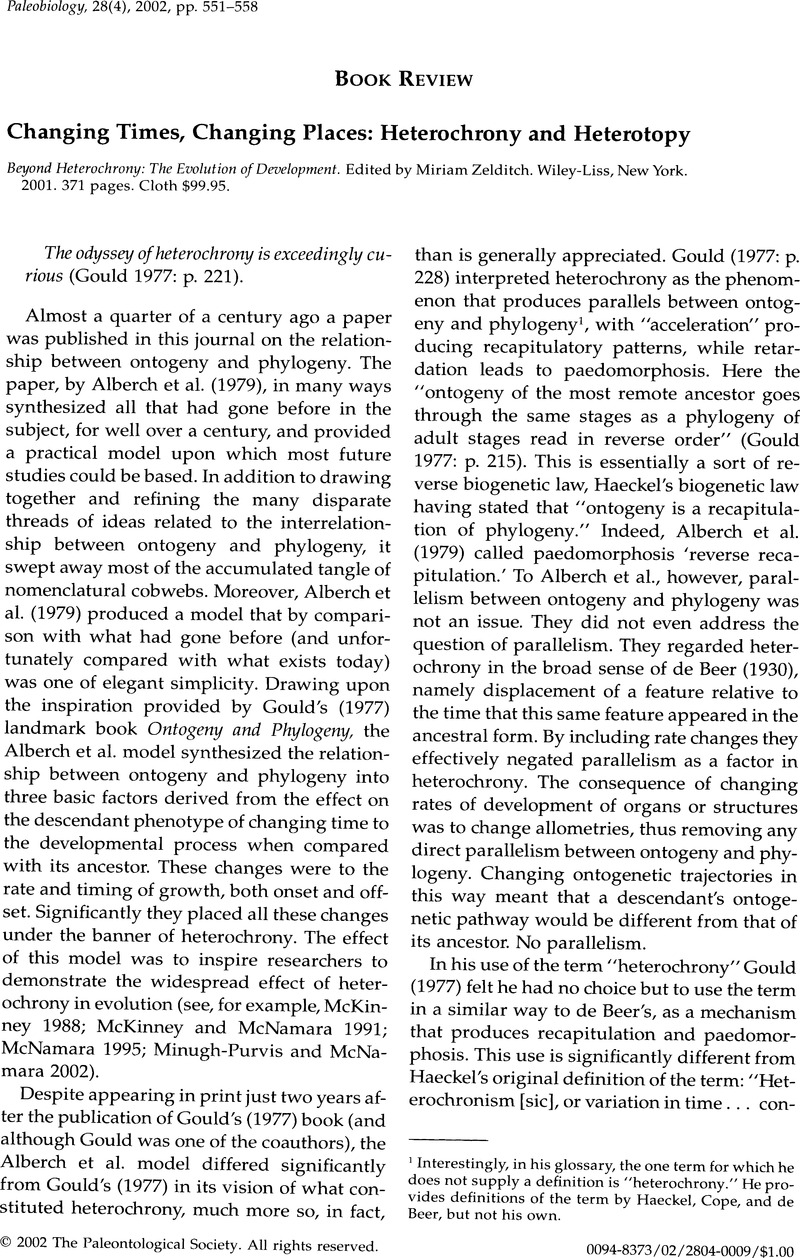No CrossRef data available.
Article contents
Changing Times, Changing Places: Heterochrony and Heterotopy - Beyond Heterochrony: The Evolution of Development. Edited by Miriam Zelditch. Wiley-Liss, New York. 2001. 371 pages. Cloth $99.95. - The odyssey of heterochrony is exceedingly curious (Gould 1977: p. 221).
Published online by Cambridge University Press: 08 April 2016
Abstract
An abstract is not available for this content so a preview has been provided. Please use the Get access link above for information on how to access this content.

- Type
- Book Review
- Information
- Copyright
- Copyright © The Paleontological Society
References
Literature Cited
Alberch, P., Gould, S. J., Oster, G. F., and Wake, D. B. 1979. Size and shape in ontogeny and phylogeny. Paleobiology 5:296–317.Google Scholar
Bookstein, F. L. 1991. Morphometric tools for landmark data: geometry and biology. Cambridge University Press, Cambridge.Google Scholar
Carroll, S. B. 1995. Homeotic genes and the evolution of arthropods and chordates. Nature 376:479–485.Google Scholar
Fink, W. L., and Zeldtich, M. L. 1995. Phylogenetic analysis of ontogenetic shape transformations: a reassessment of the piranha genus Pygocentrus (Teleostei). Systematic Biology 44:343–360.Google Scholar
Frohlich, M. W., and Parker, D. S. 2000. The mostly male theory of flower evolutionary origins. Systematic Botany 25:155–170.Google Scholar
German, R. Z., and Meyers, L. L. 1989. The role of time and size in ontogenetic allometry. II. An empirical study of human growth. Growth, Development and Aging 53:107–115.Google Scholar
Gould, S. J. 1977. Ontogeny and phylogeny. The Belknap Press of Harvard University Press, Cambridge.Google Scholar
Gould, S. J. 2002. The structure of evolutionary theory. The Belknap Press of Harvard University Press, Cambridge.Google Scholar
Hall, B. K. 1992. Evolutionary developmental biology, 1st ed. Chapman and Hall, London.Google Scholar
Hall, B. K. 1998. Evolutionary developmental biology, 2d ed. Kluwer Academic, Dordrecht, The Netherlands.Google Scholar
McKinney, M. L., ed. 1988. Heterochrony in evolution: a multidisciplinary approach. Plenum, New York.Google Scholar
McKinney, M. L., and McNamara, K. J. 1991. Heterochrony: the evolution of ontogeny. Plenum, New York.Google Scholar
McNamara, K. J. 1986. The role of heterochrony in the evolution of Cambrian trilobites. Biological Reviews 61:121–156.Google Scholar
McNamara, K. J. 1987. Plate translocation in spatangoid echinoids: its morphological, functional and phylogenetic significance. Paleobiology 13:312–325.Google Scholar
McNamara, K. J. 1988. Heterochrony and the evolution of echinoids. Pp. 149–163in Paul, C. R. C. and Smith, A. B., eds. Echinoderm phylogeny and evolutionary biology. Clarendon, Oxford.Google Scholar
McNamara, K. J. 1994. The significance of gastropod predation to patterns of evolution and extinction in Australian Tertiary echinoids. Pp. 785–793in David, B., Guille, A., Firal, J. P., and Roux, M., eds. Echinoderms through time (Echinoderms Dijon). Balkema, Rotterdam.Google Scholar
McNamara, K. J. ed. 1995. Evolutionary change and heterochrony. Wiley, Chichester, England.Google Scholar
McNamara, K. J. ed. 1997. Shapes of time: the evolution of growth and development. Johns Hopkins University Press, Baltimore.Google Scholar
McNamara, K. J. ed. 2002. Sequential hypermorphosis: the key to hominid evolution. Pp. 102–121in Minugh-Purvis, and McNamara, 2002.Google Scholar
Minugh-Purvis, N., and McNamara, K. J., eds. 2002. Human evolution through developmental change. Johns Hopkins University Press, Baltimore.Google Scholar
Parker, S. T., and McKinney, M. L. 1999. Origins of intelligence: the evolution of cognitive development in monkeys, apes, and humans. Johns Hopkins University Press, Baltimore.Google Scholar
Raff, R. A. 1996. Shapes of life: genes, development, and evolution. University of Chicago Press, Chicago.Google Scholar
Richardson, M. K. 1995. Heterochrony and the phylotypic period. Developmental Biology 172:412–421.Google Scholar
Smith, K. K. 2001. Heterochrony revisited: the evolution of developmental sequences. Biological Journal of the Linnean Society 73:169–186.Google Scholar
Smith, K. K. 2002. Sequence heterochrony and the evolution of development. Journal of Morphology 252:82–97.Google Scholar
Zákány, J., Gérard, M., Favier, B., and Duboule, D. 1997. Deletion of a HoxD enhancer induces transcriptional heterochrony leading to transposition of the sacrum. EMBO Journal 16:4393–4402.Google Scholar
Zelditch, M. L., and Fink, W. L. 1996. Heterochrony and heterotopy: stability and innovation in the evolution of form. Paleobiology 22:241–254.Google Scholar
Zelditch, M. L., Bookstein, F. L., and Lundrigan, B. L. 1992. Ontogeny of integrated skull growth in the cotton rat Sigmodon fulviventer. Evolution 46:1164–1180.Google Scholar


